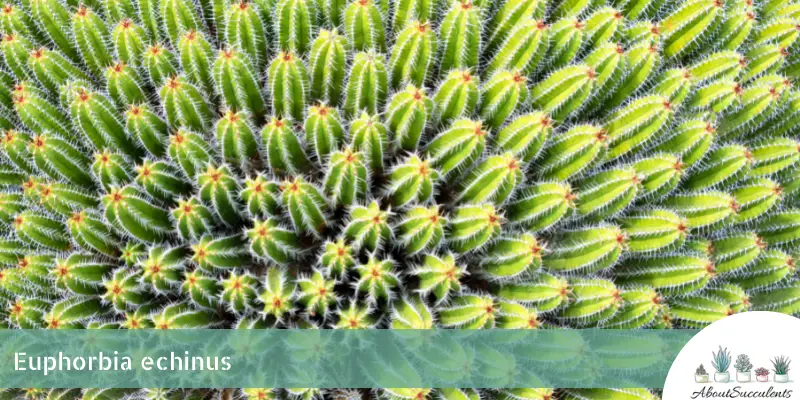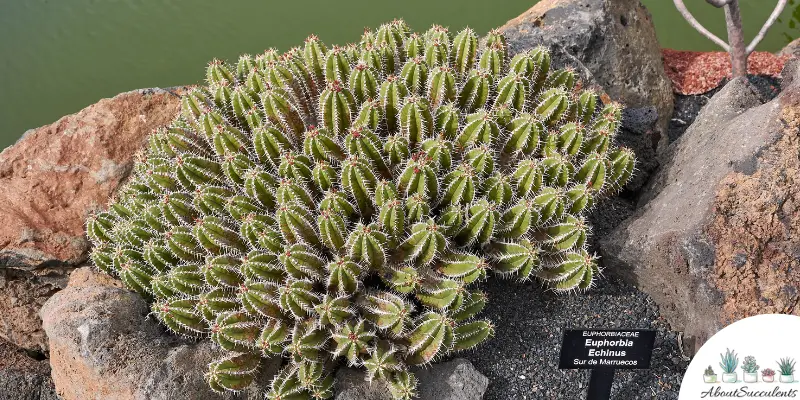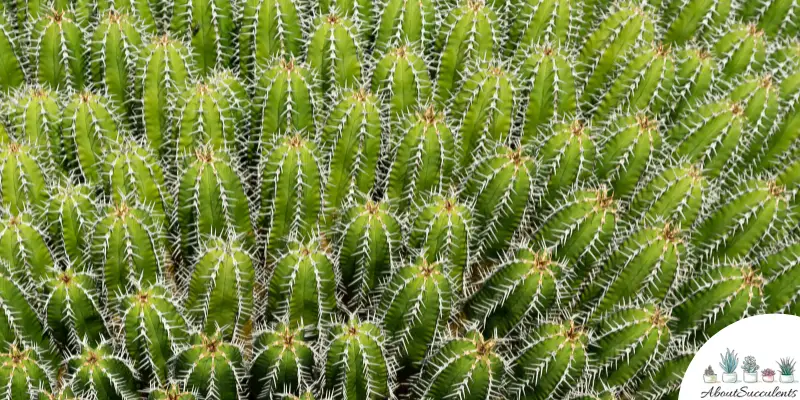
Euphorbia echinus might give onlookers the idea that it’s possible to grow corals in the desert. This endearing but thorny succulent is also often confused with cactus because the ribs on its green-colored branches are lined with spines along the ridges.
Over time, the branches spread out and give Euphorbia echinus the appearance of a spiny shrub or a grounded hedgehog.
Each species of Euphorbia echinus can have hundreds of densely-packed branches that grow out of its base. There aren’t many common names for this variety of Euphorbia except for Tikiwt. this succulent plant can reach a height of 4-feet (1.2m) with a width of 3-feet (0.9m).
In mid-summer, expect Tikwt to produce small dark red flowers that measure 0.11 to 0.15-inches (3 to 4mm) and irregularly wrinkled fruits.
Euphorbia echinus is a member of the Euphorbiaceae family and is native to Morocco, Africa, and Madagascar.
General Information
Also known as: Tikwt
Plant Family: Euphorbiaceae
Origin: Morocco, Africa, and Madagascar
Height: 4-feet (1.2m)
Exposure: Partial to full sunlight for up to 6 hours but avoid exposure to the afternoon sun
Water Needs: Give the soil a thorough soaking only if it’s 100% dry
Soil Type: Cactus mix or well-draining succulent soil with added materials such as perlite, pumice, lava rocks, and coarse to further improve drainage
Soil pH: 6.1 to 7.8
How to Grow and Care for Euphorbia Echinus

Are you planning to spruce up your rock garden? Euphorbia echinus would be a marvelous addition to your collection of outdoor succulents and give it the look and feel of the Sahara desert.
You can also grow Euphorbia indoors but locate the pot in an area that can’t be accessed by pets because of its spines and ingesting parts of it could be harmful to their health.
Growing Tikwt indoors is a good option if the temperature in your area drops below 30° F (-1.1° C) because this type of succulents cannot tolerate cold weather.
Sunlight
Euphorbia echinus does well with partial or full exposure to sunlight. Plant Tikwt in a location in the garden where it can be assured of 6 hours of morning sunlight every day.
Protect Euphorbia from the burning rays of the afternoon sun as its leaves can get severely damaged.
If you prefer Euphorbia echinus as an indoor succulent, position the pot near a window that gets 6 hours of sunlight daily. An alternative in case this isn’t possible, is to place the succulent under a Grow Light for the recommended hours.
Water
Euphorbia echinus is a drought-tolerant succulent and stores plenty of water in its leaves and stems. Like other varieties of succulents, Tikwt does better when it’s given little water.
To know for sure that it’s time to water the plant, check the soil’s level of dryness by inserting a stick an inch deep. Pull out the stick and assess carefully if it feels dry. If you’re 100% sure that the soil is dry, prepare it for watering.
Give the soil a thorough soaking. Never water the plant directly because the leaves will retain moisture longer.
If the soil is given water before it has completely dried out, it will develop fungi. The roots can rupture from prolonged exposure to water and leave the plant vulnerable to fungi infection.
Pot and Soil
Choose a pot that’s made of unglazed ceramic or terracotta as these materials support proper soil aeration and allow moisture to escape rapidly.
Check the bottom and make sure there’s a drain hole that’s big enough to filter out excess water. If it’s not included, attach a mesh net to keep soil from coming out.
When it comes to soil, the priority is also drainage. Moisture is your succulent plant’s worst enemy. Buy cactus mix or a commercially available brand of fast-draining succulent soil.
Buy a pot that’s 2 to 3-inches (5 to 7.5cm) larger than the diameter of the plant’s base. With a larger pot, the roots can grow freely without affecting the level of aeration in the soil.
To further improve drainage, add ingredients such as perlite, pumice, lava rock, and coarse sand.
How to Propagate Euphorbia Echinus

If you’re happy with how Euphorbia echinus has made your succulent garden captivating, you can have more by propagating the species. You can propagate via stem cuttings or through seeds.
Stem Cuttings Method
Step 1: Have the following tools ready before cutting a stem for propagation – Nitrile dipped gloves, a sharpened and sterilized knife, and a pair of tongs.
Step 2: Use the tong to gently pull apart a stem from the cluster of branches. Cut it off using the knife.
Step 3: Place the stem cuttings in a dry area for 2 to 4 days or until it develops hard calluses.
Step 4: Place the callused stem cuttings on a pot filled with well-draining soil.
Step 5: Lightly water the soil and place it near a window that gets partial sunlight.
Step 6: When the roots have formed, only water the soil when it’s completely dry.
Seeds Method
Step 1: Collect the seeds from the fruits that grow on Euphorbia echinus.
Step 2: Plant the seeds on well-draining cactus soil.
Step 3: Moisten the soil with a little water and cover it with plastic. You can also use a seed mat.
Step 4: Place the pot near a window that gets partial sunlight or you can use a Grow Light.
Step 5: When germination occurs, remove the plastic cover.
Step 6: Do not water the soil until it’s 100% dry.
Frequently Asked Questions
Is Euphorbia Echinus Toxic For Cats And Dogs?
Euphorbia echinus doesn’t appear on the list of plants that are toxic to cats and dogs on the website of the American Society for the Prevention of Cruelty to Animals (ASPCA).
However, there have been reports of animals getting sick if parts of Euphorbia are ingested. This is because the leaves produce a milky white sap that could be hazardous to the animal’s health. Also, the plant has spines that could injure your pet.
If you notice your pet having symptoms such as loss of appetite or vomiting, bring the animal to the veterinarian right away.
Euphorbia echinus is durable but it can be susceptible to an early death because of overwatering and pest infestation.
Overwatering
Giving Euphoria echinus more water than it needs is the leading cause of its death. If the soil is in a moistened state for a long period of time, the roots will rot and put your plant at risk of infection.
You’ll know that infection is taking place if you notice the leaves and stems developing spots that are colored yellow-brown or blackish-yellow.
To save Euphorbia, cut off the infected sections with a sterilized knife or garden shears. Every time you cut away an infected part, sanitize the cutting tool with 70% isopropyl alcohol to prevent further contamination.
Remove the plant from the soil and cut off all of the roots that have rotted. Allow Euphorbia to dry out.
Fill a new terracotta or unglazed ceramic plant with well-draining soil and replant Euphorbia echinus.
Pest Infestation
Pets might be harmed by the plant’s sap but not pests. Mealybugs, aphids, and spider mites love the sap and make Euphorbia echinus their home for this reason.
Spray the succulent with neem oil to keep the pests away. Mealybugs will leave white, cotton-like residue on the leaves. Wipe these off with a cotton ball that’s soaked in 70% isopropyl alcohol before these substances contaminate Euphorbia echinus.
Yes, Euphorbia echinus blooms dark-red or maroon-colored flowers in mid-summer that bear small, wrinkled fruits.
Last Updated on June 9, 2022 by Sofia Lara